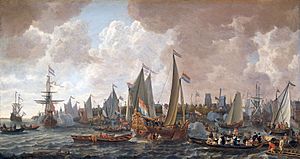HMY Mary facts for kids

The arrival of King Charles II of England in Rotterdam, 24 May 1660 by Lieve Verschuier.
Charles sailed from Breda to Delft in May 1660 in a yacht owned by the Dutch East India Company. Charles received a replica as he was impressed. |
|
Quick facts for kids History |
|
|---|---|
| Builder | Amsterdam |
| Cost | £644 |
| Fate | Gifted by the City of Amsterdam to King Charles II |
| History | |
| Name | Mary |
| Acquired | August 1660 |
| Fate | Sunk on the Skerries, 25 March 1675 |
| General characteristics | |
| Type | Yacht |
| Tons burthen | 92 tons bm |
| Length | 50 ft (15 m) |
| Beam | 18 ft 6 in (5.64 m) |
| Height | 7 ft 4 in (2.24 m) |
| Draught | 7 ft 0 in (2.13 m) |
| Sail plan | Gaff rig |
| Crew | 30 mariners, 20 gunners, 20 soldiers |
| Armament | 8/6 x 3 pdrs |
| Notes | All figures taken from |
The HMY Mary was a special ship. She was the very first Royal Yacht of the Royal Navy. A royal yacht is a fancy boat used by a king or queen.
The Mary was built in 1660 by the Dutch East India Company. This was a big trading company from the Netherlands. The City of Amsterdam bought the yacht. They gave it as a gift to King Charles II. This happened when he became king again, after a time when England didn't have a king. This gift was part of something called the Dutch Gift.
Sadly, the Mary sank on March 25, 1675. She hit rocks near Anglesey in thick fog. This happened while she was sailing from Dublin to Chester. Out of 74 people on board, 39 managed to get to safety. The ship quickly broke apart.
Years later, in July 1971, divers found the remains of the ship. They found bronze cannons and other items. When people started taking things from the wreck, a special team stepped in. They saved the remaining items. These items are now kept at the Merseyside Museums. They are there for people to see and learn from. In 1974, the Mary wreck site became a protected area. This means it's against the law to disturb it.
Building and Sailing the Mary
The Mary was the first of many yachts owned by King Charles II. He had about 27 yachts between 1660 and 1685. The word yacht comes from a Dutch word, jagen. This word means "to hunt."
The ship's bottom was covered with copper. This helped stop barnacles and other sea creatures from sticking to it. These creatures can slow a ship down. Dutch yachts like the Mary were like early Thames sailing barges. They had large sails but didn't sit deep in the water. This allowed them to sail in shallow areas.
Instead of a deep keel, the Mary used a leeboard to help her sail. A leeboard is a flat board on the side of the ship. Because she was shallow, she needed extra weight inside. This helped her stay stable in deeper waters. The Mary was built to be fancy, with a decorated back end.
The famous diarist Samuel Pepys wrote about the Mary. King Charles II loved boat racing. After owning the Mary for a year, he ordered a faster yacht. This new ship was called the Katherine. It was the first ship built for him by Phineas Pett, a famous shipbuilder.
After the Katherine was built, the Mary was used for other important jobs. She often carried diplomats and government workers. She regularly sailed across the Irish Sea between Dublin and Holyhead.
The Mary's Wreck and Discovery
On March 25, 1675, the Mary was on a regular trip. She was sailing from Dublin to Chester. In the early morning, there was a very thick fog. The ship hit rocks at the south-west part of The Skerries. This is an area off Anglesey.
The ship quickly turned over and sank. There were 28 crew members and 46 passengers on board. Only 39 people managed to get to shore. They were rescued two days later.
In July 1971, two different diving clubs found the ship's bronze cannons. These were the Chorley Sub Aqua Club and the Merseyside Sub Aqua Club. Experts from Liverpool University and the Merseyside Museums led a rescue effort. They saved many items from the wreck. This happened before people who wanted to steal things could take them.
The Liverpool City Museums Conservation Department worked to preserve the items. Today, the Merseyside Museums have over 1,500 objects from the Mary. These include things like cutlery and jewelry. There is also a model of the Mary on display.
In 1974, a law called the Protection of Wrecks Act was passed. The Mary was one of the first shipwrecks to be protected by this law. This means the site is now carefully watched. It is against the law to disturb the wreck without permission.

